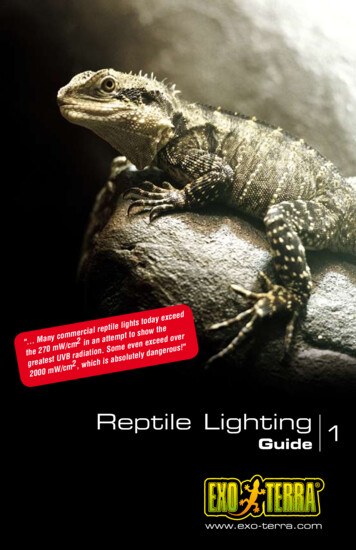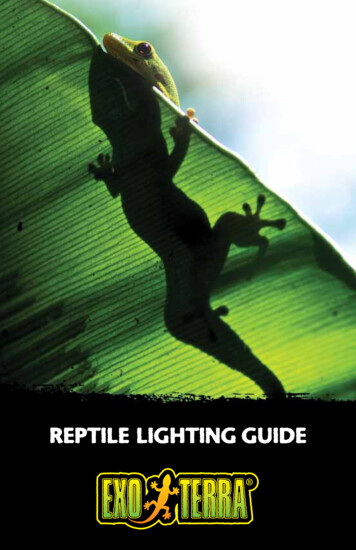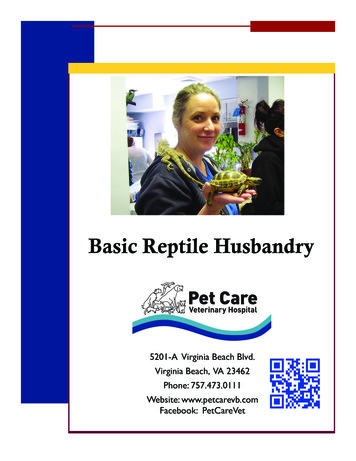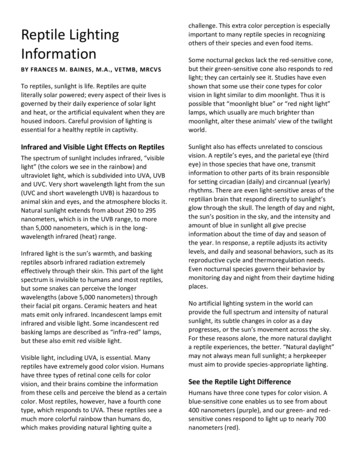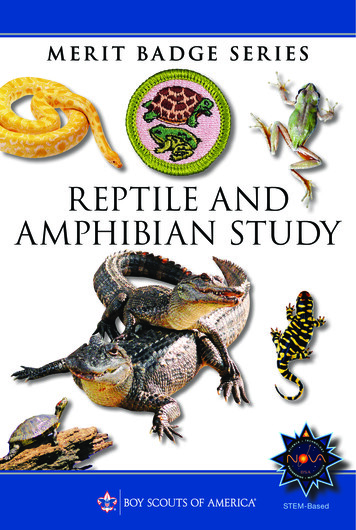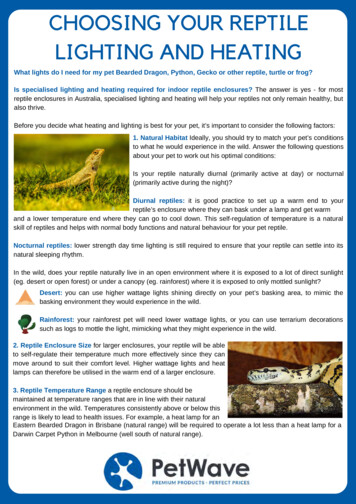
Transcription
CHOOSING YOUR REPTILELIGHTING AND HEATINGWhat lights do I need for my pet Bearded Dragon, Python, Gecko or other reptile, turtle or frog?Is specialised lighting and heating required for indoor reptile enclosures? The answer is yes - for mostreptile enclosures in Australia, specialised lighting and heating will help your reptiles not only remain healthy, butalso thrive.Before you decide what heating and lighting is best for your pet, it’s important to consider the following factors:1. Natural Habitat Ideally, you should try to match your pet’s conditionsto what he would experience in the wild. Answer the following questionsabout your pet to work out his optimal conditions:Is your reptile naturally diurnal (primarily active at day) or nocturnal(primarily active during the night)?Diurnal reptiles: it is good practice to set up a warm end to yourreptile’s enclosure where they can bask under a lamp and get warmand a lower temperature end where they can go to cool down. This self-regulation of temperature is a naturalskill of reptiles and helps with normal body functions and natural behaviour for your pet reptile.Nocturnal reptiles: lower strength day time lighting is still required to ensure that your reptile can settle into itsnatural sleeping rhythm.In the wild, does your reptile naturally live in an open environment where it is exposed to a lot of direct sunlight(eg. desert or open forest) or under a canopy (eg. rainforest) where it is exposed to only mottled sunlight?Desert: you can use higher wattage lights shining directly on your pet’s basking area, to mimic thebasking environment they would experience in the wild.Rainforest: your rainforest pet will need lower wattage lights, or you can use terrarium decorationssuch as logs to mottle the light, mimicking what they might experience in the wild.2. Reptile Enclosure Size for larger enclosures, your reptile will be ableto self-regulate their temperature much more effectively since they canmove around to suit their comfort level. Higher wattage lights and heatlamps can therefore be utilised in the warm end of a larger enclosure.3. Reptile Temperature Range a reptile enclosure should bemaintained at temperature ranges that are in line with their naturalenvironment in the wild. Temperatures consistently above or below thisrange is likely to lead to health issues. For example, a heat lamp for anEastern Bearded Dragon in Brisbane (natural range) will be required to operate a lot less than a heat lamp for aDarwin Carpet Python in Melbourne (well south of natural range).
4. Distance of Light and Heat Source the greater the distance between the heat source and the reptilebasking area, the stronger the wattage of globe required to get adequate UVB rays. For example, 15cmis too close, 30cm is ideal, and 45cm is too far. Rocks and logs can be used to manage the distanceand optimise the temperature at the basking area.5. Odour Control some light globes are specially built as negative ion generators, which can eliminateodours in your reptile habitat. By generating large amounts of negative oxygen ions, bacteria, dust andother particles are collected and drop to the ground - cleaning the air.6. Reptile Enclosure Location the location of your enclosure is an important consideration. Is theenclosure next to a window and exposed to filtered, natural light? Or is it kept in a dark room with littlenatural light? The less natural light available will increase the required day globe light strength.Importantly, only UVA light will penetrate glass windows and enclosures, while UVB light will be blocked.In their natural conditions, reptiles would be exposed to UVA, UVB, heat and infrared light from the sun.7. UVA and UVB Light: How do I get UVA light for my reptile? UVA light is known as a visible orbright light because it is the light that we can see. It is provided by an incandescent bulb. Reptiles areable to see a wider range of UVA light that is not always provided by normal human light globes.Allowing reptiles to see the full range of colours and light that they naturally see in the wild reducesstress, promotes proper feeding, encourages normal activity levels including breeding and socialising,stimulates foraging for food and makes them generally more comfortable. For comparison, imaginebeing kept in an environment where you could not see red or purple - it would be quite uncomfortable!UVA light lamps are often called “Day Lights” because they simulate the visible light of the sun duringthe day. If there is sufficient natural light in your reptile’s enclosure so that your reptile can enjoy whenthe sun is out, then “Day Lights” are only required for diurnal species.Basking lights are special UVA daytime lights with a focused beam that allows an area to be set up for areptile to bask in.How do I get UVB light for my reptile and why is it so important?Reptiles require Vitamin D3 in their system to synthesise healthy calcium levelsto maintain bones, growth and egg production. Without Vitamin D3, your reptilecan be susceptible to deadly Metabolic Bones Disease, blindness, mouth rotand other illnesses. For many reptiles, UVB light is the main way that VitaminD3 is produced. For others, they may be able to get sufficient Vitamin D3through other ways such as food. Therefore, providing UVB light is critical formany reptiles to stay healthy and thrive.What is the right UVB level for my reptile?UVB light comes in two strengths:5.0 UVB nocturnal and rainforest lizards and snakes, frogs, pythons, snakes, blue tongue lizards, water dragons,geckos, etc10.0 UVB diurnal desert lizards such as bearded dragons, goannas, monitors, etcThere are mixed views among reptile enthusiasts on which reptiles require UVB through lighting and which canget sufficient Vitamin D3 through their diets.
The reptiles listed in the table below include reptiles that definitely require UVB lamps in captivity, and those thatmay not.It’s important to note there is no harm providing all reptiles with a UVBlight, so if you are unsure it is suggested that you do provide UVB lighting.A reptile who is reluctant to eat may be stimulated to eat with exposure toboth UVA and UVB light during daylight hours, spanning over a week or so.8. Reptile Heating LampsA heating lamp is operating correctly when it is able to maintain the temperature in a reptile tankwithin the ideal temperature range of the reptile species. There are several types of reptile heaters:UVA Light Globe: in many warmer areas, UVA or daylight doubles up to provide sufficient heat foryour reptile, but in many cases, a dedicated reptile heating lamp will be required. The higher theglobe wattage, the more heat that will be emitted.Ceramic Heat Lamp: the most efficient heat lamp is a ceramic heat lamp since no light is emitted,meaning that most of the lamp energy is converted to heat through infrared light. They can also beused at night without disturbing anyone’s sleep because there are no visible UVA light rays.Ceramic heat lamps also last much longer than a day light, meaning that they are more costeffective.Infrared Heat Bulb or “Night Lamps”: infrared globes are popular lights for heating lizards. Theseglobes give off infrared light that is a soft light for humans, but not visible to Australian lizards, so itcan be a good option for night use and where a lizard is brooding its eggs or recovering from injuryor illness.Halogen lamps: halogen lights tend to have a much longer life than tungsten filament globes andare more energy efficient.Heating Pad: reptile heating mats are generally put under the reptile enclosure to warm theterrarium rocks and substrate. Modern research has shown that overhead radiant heat source isstrongly preferred and beneficial to reptiles. Heat lights provide measurable ambient heat and alsooffer a more natural day and night cycle than heating pads for your pet. Therefore, even if heatingpads are used, it is recommended that lamps are also utilised.
Always be aware that heat can dry out the air in a reptile’s home which can have severe health consequences,so it is important to regularly monitor and manage the humidity within the enclosure.Other helpful tips for lighting and heating for Australian reptiles:UVA, UVB lights and heating lamps should be placed together at one end of the enclosure illuminating thesame reptile basking area. The bright white of UVA light will attract the reptile to the warmest area so it canthen bask also in the UVB light and heat lamps.Develop a day time basking spot to allow the reptile's entire body to be heated. Ensure the basking spot is nottoo narrow as there is danger in creating a basking spot that is too narrow in focus, causing a small part ofyour pet to overheat while not warming it’s whole body. This can lead to serious burns.Ensure lamps are placed on a wire mesh surface as glass, wood, etc, as this will make the lamps ineffective.Place lamps directly above reptile enclosures as odd angles can damage your reptile’s eyes.Provide shade options for your pet reptile so that they can hide from the light when desired.Use at least two thermometers to set up and monitor the optimum reptile heating. One in the hottest spotunder the basking spot and one at the cool end of the enclosure.You can have two separate heat lamps: a day-time globe and a night-time lamp both running for 12 hours perday (using timers), simulating a natural day and night cycle. Reptiles need distinct day and night to maintaintheir circadian rhythms.UVA and UVB globes should be replaced every 6 to 12 months as they emit less light over time.Heat lamps with a ceramic socket are safer than those with plastic sockets. Due to the heat output, the plasticsockets might melt. Ceramic should always be used.Using a thermostat that operates the heat lamp only when the temperature is below the desired temperature isrecommended to ensure temperatures are maintained automatically.Ensure that your reptile cannot get too close or touch the lamp, as serious burns can result. If the lamp isinside the reptile terrarium then a protective reptile lamp anti-scald screen cover will be required.The following table describes the best temperatures for various pet reptiles. It is recommended that you allowtemperatures to drop overnight so that they approach the minimum night time temperature (but not below). Thissimulates the natural environment and is believed to have health benefits for your pet.Table 2: Reptile Species Temperature Guide (overleaf)
Table 2: Reptile Species Temperature GuideABOUT PETWAVEPetWave is an Australian online pet supply company that is expert in shipping delicate, live and frozen productsto you and your pet’s door.We know that your time is valuable & you want access to reliable, premium products at perfect prices. We areable to satisfy your needs through our premium online offer.We are very proud to offer the highest quality and largest selection of live fish, aquarium plants and driftwoodcreations, a wide range of live food such as insects, frozen pet food especially for snakes, lizards, amphibiansand birds of prey and many rare, creative and beautiful decorations for your aquarium and terrarium.Visit us at www.petwave.com.au customercare@petwave.com.au
CHOOSING YOUR REPTILE LIGHTING AND HEATING What lights do I need for my pet Bearded Dragon, Python, Gecko or other reptile, turtle or frog? . Table 2: Reptile Species Temperature Guide ABOUT PETWAVE PetWave is an Australian online pet supply company that is
